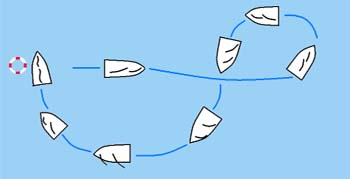The two recognized
maneuvers in the event of a man-overboard situation are
- the 'Reach and Reach' method, also known as 'Six
Second Reach' or 'Figure Eight,
- the the 'Quick Stop' method.
Since anyone in
a crew can be the person overboard, it makes sense to advise all persons
on board of what to do in the event of a MOB situation – both from being
the MOB to being on the boat during a MOB.
Apart from actually maneuvring the boat to the spot of the accident
there are a few measures to be taken as soon as it happens:
1. Anyone seeing a person go overboard should immediately shout, “Man
Overboard”, point and continue to point at the MOB and not take their
eyes off the MOB until or unless another spotter is appointed to prevent
losing sight of the person in the water.
2. Throw anything
that will help the MOB stay afloat – a life jacket, a life ring, a boat
cushion etc. These items will also help mark the location of the MOB.
3. The skipper should
appoint a spotter – usually the person who initially saw the MOB.
4. Shout words of
encouragement to the MOB. “Don’t worry, we will get to you.” “Stay calm,
we are just turning around to come back for you.” etc.
5. Stay calm on
the boat. Follow the skipper's instructions.
a. Once close
to the MOB the skipper will give directions to throw the MOB a floatable
line. If the line is not attached to a sling or life ring, make a large
loop in the end using a bowline so that the MOB can place the line around
his body and under the arms.
b The skipper
will likely direct that all sails be lowered in order to hold the boats
position.
6. Slowly pull the
MOB to the boat making sure that the s/he is able to keep his face out
of the water. Pulling too quickly may pull them under.
7. Once beside the
boat, pull the MOB aboard. S/he may not be able to offer much assistance.
If the MOB is too heavy to pull aboard by crew power alone, run a line
from a forward cleat back to a cockpit winch. Dip the (non-floating)
line over the side so that the MOB can stand on it. Winch in the line
to raise the MOB to deck level.
An alternative
to the above is to push the boom out over the MOB, using a block and
tackle system attached to the boom, hoist the MOB out of the water and
then swing the boom back over the deck to recover the MOB.
8. Once back onboard,
check the MOB for physical injuries and treat for hypothermia if necessary.


